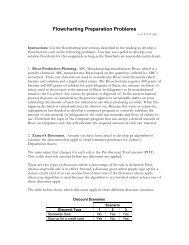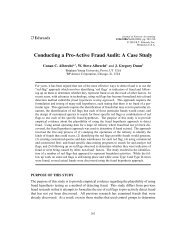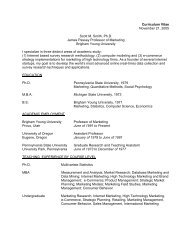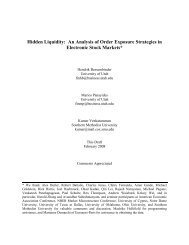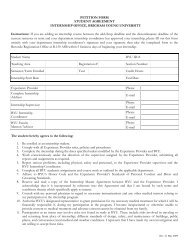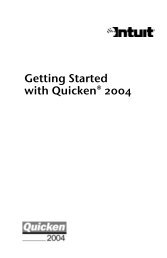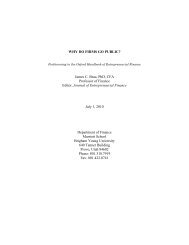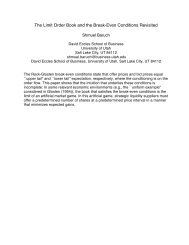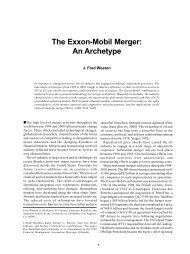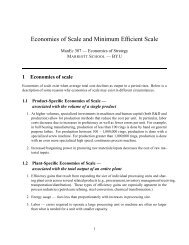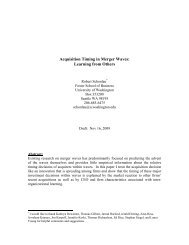Albrecht 19.pdf - Marriott School
Albrecht 19.pdf - Marriott School
Albrecht 19.pdf - Marriott School
You also want an ePaper? Increase the reach of your titles
YUMPU automatically turns print PDFs into web optimized ePapers that Google loves.
76154_23_ch19_p942-1006.qxd 3/1/07 3:35 PM Page 974<br />
974 Part 6 Control in a Management Accounting System | EM<br />
volume variance<br />
The difference between<br />
the expected (or<br />
budgeted) production<br />
output established at the<br />
beginning of the reporting<br />
period and the actual<br />
production output. This<br />
difference is then<br />
converted into a dollar<br />
number by multiplying it<br />
by the standard fixed<br />
manufacturing overhead<br />
costs per unit.<br />
CAUTION<br />
Generally, one would expect little change in fixed costs unless a decision is made by<br />
management to make a direct change to a cost item. Hence, buying or selling property,<br />
changing the insurance contract, adjusting the depreciation schedule, or personnel<br />
changes will affect the actual fixed costs incurred. Apparently, Sunbird’s insurance contract<br />
didn’t change. There were some differences in property taxes (likely due to a tax<br />
rate increase by the local government) and salaries (perhaps a shift in personnel serving<br />
in management roles). It also appears that Sunbird saved a little money on supervisor<br />
salaries, perhaps due to staff changes in the company. The largest impact on the fixed<br />
overhead budget variance came from depreciation. This variance should be investigated.<br />
Perhaps the company accountant made a change to the depreciation method, or perhaps<br />
more expensive equipment was acquired during the year. It’s important to understand<br />
that variances do not provide answers in the management process. Variances signal questions<br />
that need to be asked by management.<br />
Remember that overhead costs are applied on<br />
the basis of standard direct labor hours<br />
allowed, and not on the actual direct labor<br />
hours used. Sunbird will apply $1,600 in<br />
fixed manufacturing overhead to each boat<br />
produced regardless of how many hours are<br />
actually used to produce the boat.<br />
FYI<br />
Managers who understand how to use the<br />
volume variance as a performance measure<br />
know that this dollar figure doesn’t really<br />
indicate the volume of costs flowing into or<br />
out of their organization. They know that if they<br />
divide this number by the predetermined fixed<br />
manufacturing overhead rate per unit, they can<br />
then see exactly how many units were actually<br />
produced above or below the expected level<br />
of production.<br />
Volume Variance. The $8,000 unfavorable volume variance shown in the<br />
illustration above is a variance unlike any other we’ve studied in this chapter.<br />
Every variance studied thus far has been an input variance; that is, it has been either<br />
a variance on how much was spent on the input (materials price, labor rate,<br />
variable overhead spending, fixed overhead budget) or a variance on how much<br />
of the input was used (materials quantity, labor efficiency, variable overhead efficiency).<br />
The volume variance is an output variance and measures the difference<br />
between expected and actual production volumes.<br />
In the case of Sunbird Boat Company, you will recall that at the beginning of<br />
the year management expected to produce 105 15-foot boats. However, at the end<br />
of the year the company had only produced 100 boats. This is an unfavorable volume<br />
variance, and the amount of that variance is five boats. The problem in a standard<br />
costing system is that you can’t debit or credit “five boats” into the accounting<br />
system. To record this variance requires that the difference between expected and<br />
actual output volume be changed into a dollar amount. This is done using the fixed<br />
manufacturing overhead rate of $20.00 per direct labor hour. Based on the production<br />
standards used to establish its standard costs, Sunbird allocates $1,600 (80 standard direct<br />
labor hours allowed $20.00 per direct labor<br />
hour) in fixed manufacturing overhead<br />
to each boat produced. (Remember that<br />
Sunbird established the $20.00 rate based on<br />
an expectation of producing 105 boats and<br />
uses the rate to allocate the budgeted fixed<br />
costs of $168,000.) Because Sunbird only produced<br />
100 boats, it only allocated $160,000<br />
($1,600 100 boats). In other words, Sunbird<br />
underapplied its fixed manufacturing<br />
overhead costs by $8,000 ($168,000 <br />
$160,000), which results in an unfavorable<br />
volume variance of $8,000. Another way of<br />
calculating this volume variance would be to<br />
simply multiply the unfavorable volume difference<br />
of five boats by the $1,600 per-boat<br />
application rate. This fixed overhead volume<br />
variance can be thought of, roughly speaking,<br />
as underapplied fixed manufacturing<br />
overhead costs (we discussed this concept<br />
earlier in Chapter 16). Because Sunbird actually<br />
produced fewer boats than originally expected<br />
when it set up the $1,600 application<br />
rate, not enough fixed costs were applied to<br />
production during the year.



